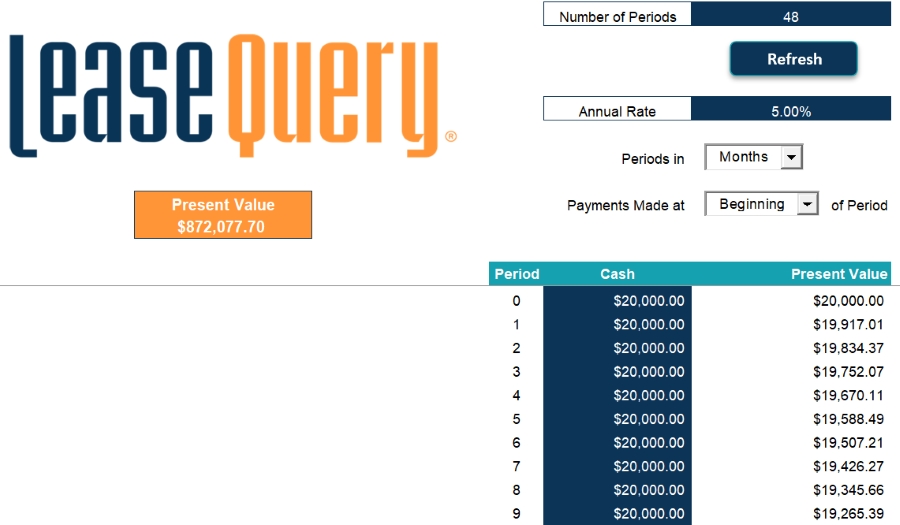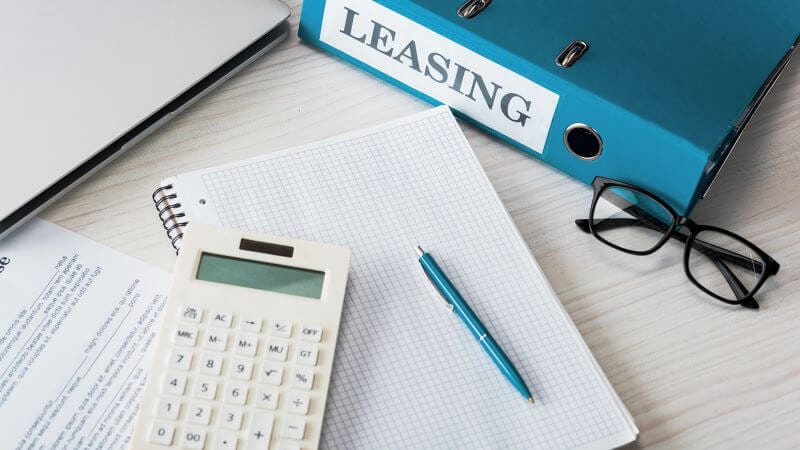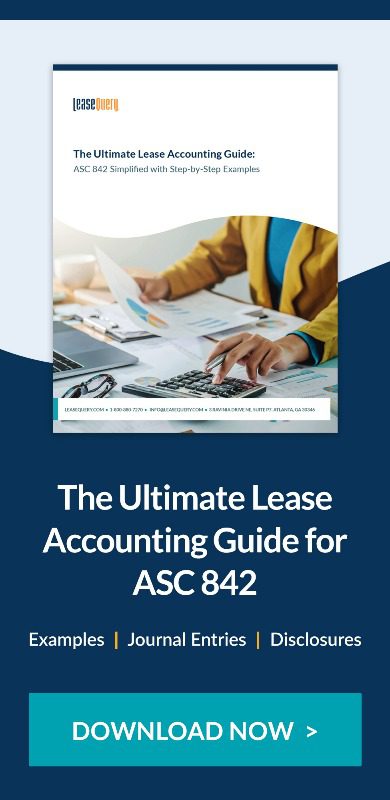2. Understanding lessee vs. lessor
3. Lease accounting under the old standards
4. Lease accounting standards: changes and full examples
5. Why were new standards implemented?
6. Lease accounting calculations you need to know
- Present value of future lease payments
- Lease amortization schedule
- Right-of-use asset
- Straight-line rent expense
- Discount rate or interest rate
7. Embedded leases in lease accounting
8. Lease accounting software: Why is there a need for it?
9. Benefits of the new lease accounting standards
10. Related articles
What is lease accounting?
Lease accounting is the process organizations use to record the financial impact of their leases. Businesses and other entities are required to record the majority of their leases on the balance sheet in accordance with the guidance established under standards from various accounting boards. Some of these include the following:
- ASC 842 maintained by the FASB for the United States
- IFRS 16 maintained by the IASB internationally
- GASB 87 maintained by the GASB for US state and local governmental entities
- SFFAS 54 maintained by the FASAB for US federal entities
- FRS 102 maintained by the FRC for the United Kingdom and Irish entities
Among other changes, these entities are now required to record both operating leases and capital/finance leases to the balance sheet, a major divergence from the legacy standards.
Understanding lessee vs. lessor
The terms “lessee” and “lessor” are used to identify the different parties involved in a lease agreement. This distinction is important because the accounting for a lessor is significantly different from that of a lessee. When the various accounting boards for the domestic, international, and governmental entities issued these standards, the underlying definitions of lessor and lessee were not changed. They did, however, change some of the accounting treatment for lessors and lessees.
Lessee definition
A lessee is defined as the entity paying for the use of specific property from a lessor. For example, if a person leases a vehicle from a car dealership, the person using the car is the lessee. Conceptually, the lessee is paying the lessor for the “right to use” the asset. This is why the lessee, per the new lease standards, is required to recognize an intangible “right-of-use asset” (ROU asset) or a “lease asset” when accounting for the lease. It is important to note this asset is classified as an intangible asset on the lessee’s books, rather than a fixed asset.
Lessor definition
A lessor is defined as an entity (i.e. a person, company, or organization) providing the right to use an asset for a period of time in exchange for consideration. One of the more common scenarios of a lease agreement is an entity renting their owned property to another entity for a monthly cash payment. For example, if an organization owns a building and leases the right to use the building or space within the building, the owner of the building is the lessor, also commonly referred to as the landlord.
Lease accounting under the old standards
Among others, the legacy lease accounting standards included ASC 840, IAS 17, and various GASB standards, mainly GASB 13 and GASB 62. Before the announcement of new lease accounting standard requirements, most companies did not find it essential to pay close attention to operating leases within the financial reporting process. This was because lessees with operating leases would only recognize an expense over the lease term with limited balance sheet impact.
The accounting for capital leases, known as finance leases in some cases, was more complex under the legacy standards. Entities were required to recognize the capitalized assets and liabilities from capital/finance leases and amortize them over a specific period.
Lease accounting standards: changes and full examples
The FASB, IASB, GASB, FASAB, and FRC have released new lease accounting standards over the last several years, which are ASC 842, IFRS 16, GASB 87, SFFAS 54, and FRS 102, respectively.
Initially, the FASB worked in conjunction with the International Accounting Standards Board (IASB) to develop their new standards, but there were eventually significant differences between ASC 842 and IFRS 16.
The GASB and FASAB developed their standards independently and, likewise, there are notable differences between GASB 87 and ASC 842. The FRC later developed FRS 102, aiming to somewhat mirror IFRS 16.
All companies that lease assets are affected by the new standards. Some considerations exist within each standard to omit specific types of transactions from capitalization (i.e. short-term leases). However, all companies with the right to use at least one in-scope asset qualifying as a lease will need to apply the respective standard.
Under most of these standards, the primary change to lease accounting is that lessees must recognize lease assets and lease liabilities on their balance sheets for the majority of their lease arrangements. Lessees are required to calculate the present value of future lease payments to establish a lease liability and the related ROU asset. FinQuery offers a free present value calculator to help accountants with this task:

For lessors, the accounting differs depending on the standard. Under GASB, for example, lessors must mirror the accounting on the lessee side, recognizing a lease receivable and deferred inflow of resources. Under ASC 842, however, lessor accounting remains largely unchanged.
Other changes include:
- Lease classifications
- Lease definitions
- How initial direct costs (IDC) are defined
- More extensive disclosure requirements
- The treatment of lease and non-lease components
Below are summaries of lessee and lessor accounting under ASC 842, IFRS 16, GASB 87, SFFAS 54, and FRS 102.
ASC 842
ASC 842 is the lease accounting standard for entities reporting under US GAAP. Lessees reporting under ASC 842 are required to recognize lease assets and lease liabilities on their balance sheets for both operating and finance (previously capital) leases. The lessee is required to perform a present value calculation of future expected lease payments to establish the lease liability and the related ROU asset. Accounting for leases classified as operating leases is affected the most, as leases classified as capital leases were already recognized on the balance sheet under ASC 840.
The accounting for lessors was mostly unchanged from ASC 840 to ASC 842. Lessors continue to recognize lease income for their leases, and balance sheet recognition requirements are predominantly the same. The lease agreement’s underlying asset is still classified as the lessor’s fixed asset.
Under ASC 842, there are three types of lessor leases:
- Direct Financing – lessors are required to establish a lease receivable and interest income
- Sales Type – lessors are required to establish a lease receivable and interest income. The difference between direct financing and sales-type leases is revenue (With a sales type, the lessee has control of the underlying asset and the lessor recognizes sales revenue and profit at lease commencement)
- Operating – lessors recognize income on a straight-line basis
ASC 842 lease accounting examples
Below are some articles to further explain finance and operating lease accounting under ASC 842, including full examples, journal entries, and disclosure requirements:
- Operating Lease Accounting under ASC 842 Explained with a Full Example
- Capital Lease Accounting and Finance Lease Accounting under ASC 842 Explained with a Full Example
- ASC 842 Disclosure Requirements: Example and Explanation
IFRS 16
IFRS 16 is the international lease accounting standard. Like ASC 842, this pronouncement also requires lessees to recognize a lease liability calculated as the present value of the expected lease payments and a related ROU asset. Unlike ASC 842, however, IFRS 16 requires all lessee leases to be classified as finance leases, eliminating the operating lease classification. The standard became effective on January 1, 2019.
For lessors, the operating and finance classification model still continues. Lessors are required to determine if a lease is classified as an operating or finance lease and use the appropriate accounting treatment.
The main driver between operating and finance leases for lessors under IFRS 16 is transfer of ownership. Lease agreements where the lessor maintains ownership are operating leases. For operating leases, the lessor continues depreciating the leased asset and records the incoming lease receipts as revenue on a straight-line basis over the lease term.
When the lease agreement is classified as a finance lease, the lessor must calculate the net investment in the lease using the present value of future expected lease receipts and record this amount as a receivable. Lessors are also required to derecognize the carrying value of the underlying asset. Any difference between the net investment in the lease and the carrying value of the underlying asset is recognized as a gain or loss on the income statement.
IFRS 16 lease accounting examples
These two articles include examples of lease accounting under IFRS 16 with journal entries:
- IFRS 16 Leases: Summary, Example, Journal Entries, and Disclosures
- Interest Rate Implicit in the Lease under IFRS 16 Explained
GASB 87
GASB 87 is the lease accounting standard for governmental entities in the United States that report under GASB. GASB 87 became effective for fiscal years beginning after June 15, 2021. Like IFRS 16, GASB 87 also uses a single model approach, in which all leases are classified as finance leases.
This standard requires lessees to recognize a lease liability and related lease asset at the commencement date of the lease. The lease liability is equal to the present value of the expected lease payments over the lease term and the related lease asset is equal to the lease liability with a few minor adjustments.
Lessors under GASB 87 should record a lease receivable and a deferred inflow of resources at the commencement of the lease term. As with the lease liability for a lessee, the lease receivable is calculated as the present value of the lease receipts expected during the lease term. The deferred inflow of resources is equal to the lease receivable with a few minor adjustments and is similar to deferred revenue.
The GASB intends for lessor accounting to effectively mirror lessee accounting under the new lease accounting standard. This is accomplished by the lessee and the lessor recognizing the present value of the expected remaining lease payments or receipts, respectively, offset by the corresponding ROU asset and deferred inflow of resources.
GASB 87 lease accounting examples
Here are two articles providing a walkthrough of accounting under GASB 87, including full examples and journal entries:
- GASB 87 Explained with a Full Example of the New Governmental Lease Accounting Standards
- GASB 87 Lessor Accounting Example with Journal Entries
SFFAS 54
SFFAS 54 is the lease accounting standard for the United States federal entities reporting under FASAB. It is effective for reporting periods beginning after September 30, 2023.
This standard requires lessees to record a lease liability, recognized as the present value of expected lease payments over the lease term, and a corresponding lease asset. Subsequently, lessees must apply the discount rate to the lease liability to recognize periodic interest expense.
Lessors are required to establish a lease receivable and an unearned revenue liability upon lease commencement. The lease receivable is measured at the present value of the expected lease payments and reduced by any provision for uncollectible amounts, if applicable. The periodic interest revenue is recognized based on the interest calculated on the lease receivable.
SFFAS 54 defines certain exemptions and scope limitations for lessors and lessees. The standard does not apply to accounting for leases prior to the commencement of the lease term. Non-intragovernmental short-term leases, defined as those with a term of 24 months or less, are also exempt from disclosure under SFFAS 54. Intragovernmental leases are considered “out-of-scope.” However, lessees and lessors are still required to disclose these types of leases.
SFFAS 54 lease accounting example
For a full example of SFFAS 54 with journal entries, read the following article:
FRS 102
FRS 102 is the new financial reporting standard for businesses and other entities in the United Kingdom and Ireland reporting under the Financial Reporting Council (FRS). Among other changes within the standard, recent amendments by the Financial Reporting Council (FRC) will significantly change the accounting treatment for lessees, aligning FRS 102 more closely with IFRS 16, while lessor accounting remains largely unchanged.
Currently, lessees reporting under FRS 102 classify leases as either finance or operating leases. However, the new amendments will largely remove this distinction, adopting a single-model approach similar to IFRS 16. Lessees are required to recognize a right-of-use (ROU) asset and a lease liability for the majority of their lease agreements on the balance sheet. The lease liability is calculated as the present value of future lease payments and the ROU asset is depreciated over the shorter of the lease term or the asset’s useful life.
Lessors will continue to classify leases as either finance leases or operating leases. Operating lease payments will remain as income, recognized on a straight-line basis. For finance leases, lessors must derecognize the asset and recognize it as a lease receivable over the duration of the lease term.
These amendments are scheduled to take effect on January 1, 2026.
FRS 102 lease accounting example
This article provides a full example of FRS 102 with journal entries:
Why were new standards implemented?
The new standards were implemented to enhance transparency into entities’ financial obligations. Leases have long been a blind spot for financial statement users. Each of the standards requires entities to bring most leases onto the balance sheet.
After the financial scandals of the early 2000s, regulators and legislators issued numerous regulations and laws to reduce corporate fraud. However, lease obligations remained opaque. During The Great Recession of 2008, several firms with major leasing liabilities went bankrupt, despite having balance sheets that appeared clean. With operating lease liabilities not recognized on the balance sheet, investors did not have a full picture of a company’s obligations.
The new lease accounting standards aimed to:
- Offers fewer opportunities for organizations to manipulate lease transactions to avoid recognition on the balance sheet
- Provide more comprehensive insight into a lessees’ obligations
- Reduce the need for stakeholders to compensate for the lack of financial visibility by adjusting the recognized liabilities on financial statements
- Align lessor accounting and guidelines for sale-leaseback transactions with the comparable 2014 revenue recognition standard, ASC 606
- Expose lessors’ credit and asset risk as a result of leasing
- Clarify the definition of a lease and how to specifically identify an embedded lease within a contract
Lease accounting calculations you need to know
There is a complex set of calculations you have to complete to be fully compliant when preparing your financial reports. Below are some calculations that are necessary to account for your leases:
Present value of future lease payments
Present value is the calculation of what a future sum of money or stream of cash flows is worth today given a specified rate of return over a specified period. Under the new lease accounting standards, lessees are required to calculate the present value of any future lease payments to determine the obligations to be recorded on the balance sheet for both operating and finance leases. The calculation is performed using the term and payments specified in the lease and a rate of return that is specific to either the lease or the organization. The present value of the lease payments is used to establish both a lease liability and a right-of-use asset.
Lease amortization schedule
The lease liability is the present value of the future lease payments and is recorded alongside the right-of-use asset for operating and finance leases. Under ASC 842, the lease liability is not considered debt. Under IFRS 16 and GASB 87, however, a lease liability is considered long-term debt. It’s important to know how to properly calculate the lease liability amortization schedule whether you plan to use Excel or lease accounting software. The more you know, the better you’re able to ensure that the calculation is accurate.
Right-of-use asset
The right-of-use asset, or ROU asset, is the value of the lessee’s right to control the use of a specific asset over a specific period. Under ASC 842, the ROU asset is calculated as the lease liability amount and any lease prepayments plus any direct costs, less any lease incentives. ROU assets and lease liabilities are presented separately on the balance sheet.
Straight-line rent expense
The concept of straight-line rent expense requires lessees to charge their total lease liability to expense on an even, periodic basis over the lifetime of the contract. Similar to straight-line depreciation, this method is required to evenly recognize a fixed asset over its useful life. Similarly, straight-line rent expense is calculated by aggregating all rent payments and dividing them by the full contract term.
Discount rate or interest rate
Determining the right discount rate or interest rate can be tough under any standard. The discount rate implicit in the lease is the most appropriate discount rate to use for your lease calculations. If you’re unsure about the implicit rate after combing through the lease, there are ways to determine the rate on your own. First, determine the fair value of the asset at the beginning and end of the lease, and what your payments are. Then, use that information to conduct a present value calculation. If you don’t know or are unsure about the fair value of the asset, you would then use the incremental borrowing rate. If you’re a private company reporting under ASC 842 and cannot find any of the rates above, you can also use the risk-free rate. Finally, we offer a free Excel calculator to help you determine the rate implicit in your leases under ASC 842:
In addition to the calculations outlined above, you’ll also need to consider the liability reduction, asset lease expense, weighted average discount rates for operating and finance leases (under ASC 842), and the weighted average lease term for finance and operating leases (under ASC 842).
Beyond these items, you’ll need to consider the necessary disclosures that use these calculations but report on them in different ways.
Embedded leases in lease accounting
One of the biggest challenges entities face when compiling their lease portfolio involves identifying their embedded leases. A typical real estate lease can require legwork to gather the appropriate data, but the process of identifying the lease itself does not provide immense difficulty.
Embedded leases, which refer to leased assets provided within service, outsourcing, and maintenance contracts, may require additional work to discover. Examples of contracts that can contain embedded leases include:
- Warehousing contracts – although typically outsourced, these agreements may contain language that meets the definition of a lease.
- Security contracts – these types of services may also contain access to scanners or equipment, which could qualify as a lease under the standard’s definition.
- Transportation contracts – depending on the terms, the vehicles used for transport could qualify as a lease asset.
- Data storage contracts – much like security contracts, these agreements could include embedded leases for both the servers or the space the servers occupy.
Departments responsible for procurement will not typically have a comprehensive understanding to know whether the contract includes any assets that qualify as an embedded lease. We offer a free test to help you identify leases embedded in your contracts:
Lease accounting software: Why is there a need for it?
Excel and accounting go hand in hand. Excel offers the ability to achieve nearly any result desired – or so many think. However, for compliance with the leasing standards, Excel has limitations considering their complexity. Too many opportunities exist to introduce human error into the calculations and risk noncompliance. This is one of the reasons why audit firms suggest using lease accounting software.
Additionally, lease software provides the ability to house all of your organization’s leases in a central repository and provides access to all necessary users, rather than only to contract owners. Ideally, this central repository will provide access to the document, amortization schedules, critical date alerts, journal entries, and footnote disclosures all at once.
To address the complexity of the new standards, companies must look to software built specifically for lease accounting, such as LeaseQuery.
Whatever lease accounting software you use, it should address the accounting, reporting, and document management needs your company, auditors, and regulators require. Considering the judgmental nature of these new standards, companies should also ensure they have lease accounting experts at their disposal to assist in navigating the complexities and nuances of the standards.
Choosing the right lease accounting solution
Choosing and implementing your lease accounting software should be done carefully and not happen overnight. When comparing solutions, you should consider the following:
- Whether the software supports its internal controls
- Whether the provider completes a system and organizational controls audit of both design and operating effectiveness
- User reviews – and what specific role the reviewer has within their organization
While budget constraints may make pricing an initial decision factor, evaluating on price alone will only lead to costly headaches in the long run.
The same goes for choosing to use lease management software that was not originally architected for accounting compliance. Many lease management companies have added accounting modules to their software. However, those programs often include shortcomings, as the product teams usually lack the expert guidance of lease accountants.
Benefits of the new lease accounting standards
The new standards have driven various departments in many organizations to work together more seamlessly to manage and account for leases. The implementation of the new standards provided an opportunity for them to integrate processes and tools so all stakeholders have the same understanding of lease agreements and how the contracts affect the business.
Companies that implemented lease accounting software have found their facilities, procurement, and other leasing departments now provide more complete data when entering into new contracts. As a result, accounting now spends fewer hours gathering information and devotes more time to achieving core business goals. Furthermore, compliance with the new standards provides exactly what the accounting boards are designed to ensure: financial comparability and transparency amongst organizations across all industries and sizes!















